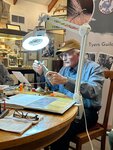October weather continues to be exceptional - with chilly mornings warming up to beautiful sunny days. We do need rain, as our rivers and streams have been well below average for several weeks. Water …
This item is available in full to subscribers.
Please log in to continue |


October weather continues to be exceptional - with chilly mornings warming up to beautiful sunny days. We do need rain, as our rivers and streams have been well below average for several weeks. Water temperatures have been in the 50s to 60s thanks to the cool evenings and mornings.Fishing has been somewhat productive; fly hatches continue to be tiny Blue-Winged Olives, medium-sized Light Cahills and the larger Isonychias, especially in the afternoons.
Traditionally, anglers fish with streamers during this time of year, as these below-the-surface flies imitate minnows, and can entice a larger trout to take. I remember the first time I fished with a streamer. The river was low and clear and I wasn’t sure that I could “fool” the fish, and was not yet confident in my fishing-below-the-surface abilities. We were fishing on theBeaverkill, and my husband, Ed, suggested that I stand on a rock so that I could see the water beneath me and have a better view of what the fly could do. I tied on a Mickey Finn, which was a favorite of my father’s, made one false cast and lobbed it across the water. It started to float with the current downstream, and because I was standing on the rock above, I could see it clearly.
It looked like a small minnow. Once the fly straightened out, I started to “twitch” the rod, holding the line still with my left hand, making the fly move slightly upstream. I really enjoyed bringing life to the fly and making it “swim” under the surface. Because the water was low and clear, I could see a trout approaching, and was caught up in enticing the trout to take the streamer. It was like playing with a cat, where you tie an object on the end of a long string and move it along just far enough ahead of the cat’s pounce. It felt like I was teasing the trout by making the fly dart ahead just a few inches at a time - looking very life-like - until the trout grabbed the fly, and I set the hook! It was exciting to see the whole scenario play out-and to this day, I feel the same satisfaction remembering that first experience of fishing with a streamer fly. On the subject of streamers, Saturday’s guest fly tier at the CFFC Museum was Catskill Fly Tyers Guild Vice-President, John Apgar. John displayed the streamers he was tying: the Little Rainbow, Little Brown and Little Brook Trout flies. He set out a colorful array of materials to use, including several brightly dyed bucktails and a beautiful Junglecock neck that is often used to imitate the “eye” of a streamer fly. John spent some time teaching a youngster from Pine Bush how to tie a fly for the first time; the boy and his family were beaming at the end of the session. These Saturday tying sessions, which are free of charge, are especially appealing to families with youngsters who are eager to learn to fish and tie flies but have no one at home to teach them. When asked for tips for tying these flies, John replied:
“As for suggestions on tying Bucktails, always use less than you think you need.Sparsely tied always looks better, maybe start with a small clump of hair 20 to 25 strands, then thin out the too long and too short ones and it should be just about right. When layering colors the bottom color is the shortest and each additional layer is just slightly longer.
I usually put a drop of clear nail polish over the cut ends once the layering is complete too, helps hold things together and also helps seal the head of the fly once done.”
Comments
No comments on this item Please log in to comment by clicking here